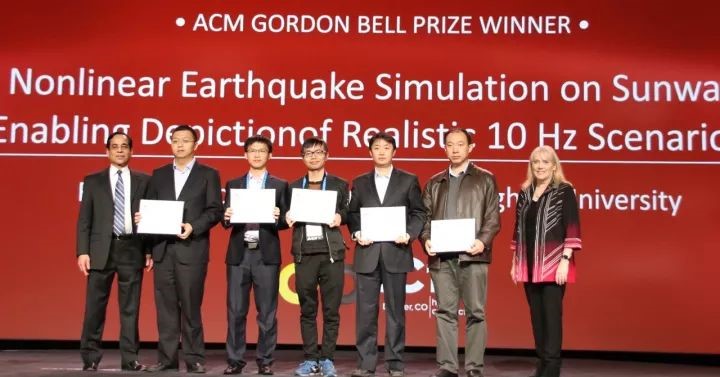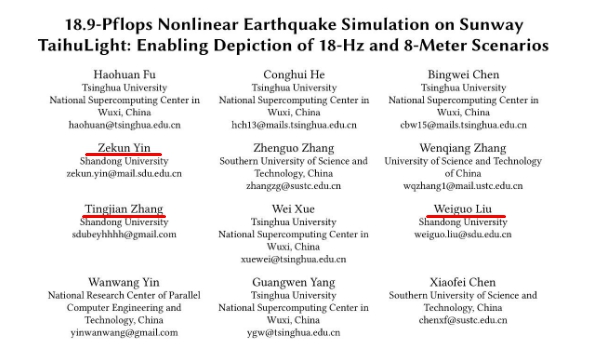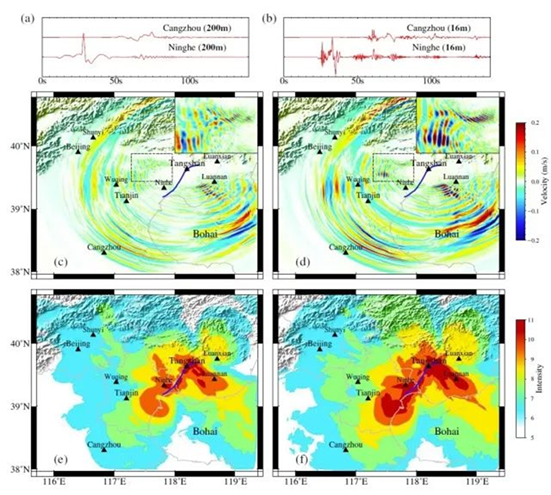
Second from the right is Prof. Liu Weiguo
The research project18.9-Pflops Nonlinear Earthquake Simulation on Sunway TaihuLight: Enabling Depiction of 18-Hz and 8-Meter Scenarios was awarded the AMC Gordon Bell Prize, the top award in the field of supercomputing on November. Prof. Liu Weiguo and his team members Yin Zekun and Zhang Tingjian from Shandong University made significant contributions to this work.
This research project was jointly completed by the Department of Earth System Science and the Department of Computer Science and Technology, Tsinghua University together with Shandong University, Southern University of Science and Technology, the University of Science and Technology of China, the National Research Center of Parallel Computer Engineering and Technology, China and the National Supercomputing Center, Wuxi, China. The SDU team led by Prof. Liu Weiguo undertook the design and optimization of the super computer's key algorithm.
Of the 12 authors of this paper, 3 are from Shandong University.

authors of the paper
Although earthquake prediction and simulation is an inexact and emerging area of research, scientists hope that the use of supercomputers, which can process vast sets of data to address the myriad of variables at play in geologic events, may lead to better prediction and preparedness. For example, the Chinese team's 3D simulations may inform engineering standards for buildings being developed in zones known to be prone to earthquakes. In this vein, many have advocated for a significant increase in the amount of sensors to regularly monitor seismic activities.
The Tangshan earthquake, which occurred on July 28, 1976 in Tangshan, Hebei, China, is regarded as the most devastating earthquake of the 20th century. In developing their simulations for the Tangshan earthquake, the winning team included input data from the entire spatial area of the quake, a surface diameter of approximately 320 km, as well as 40 km deep below the Earth’s surface. The input data also included a frequency range of the earthquake of up to 18 Hz (Hertz). In the study of earthquakes, a Hertz is a unit of measurement that measures the number of times an event happens in the period of a second.
For example, it might correspond to the number of times the ground shakes back and forth during an earthquake. Previous simulations of violent earthquakes have employed a lower frequency than 18 Hz, since enormous memory and time of computation are needed for high frequency simulations.

The simulation results of Tangshan earthquake
The Gordon Bell Prize, awarded each year at the annual supercomputing conference, was established in 1987 by Gordon Bell, a pioneer in high-performance and parallel computing. It tracks the progress of parallel computing and rewards innovation in applying high performance computing to challenges in science, engineering, and large-scale data analytics.
Related readings:
[Xinhua] Chinese researchers win "Nobel Prize" of supercomputing application
[People's Daily] Chinese TaihuLight team wins Gordon Bell Award
[CCTV] China's Sunway TaihuLight software wins Gordon Bell Prize for second time
[China Daily] Chinese researchers win 'Nobel Prize' of supercomputing application
[CRI online] Chinese researchers win "Nobel Prize" of supercomputing application
[The Next Platform] Gordon Bell Looks Out Into A Parallel World
Written by: Yin Zekun
Edited by: Xie Tingting